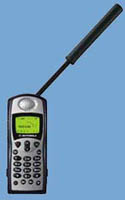
Globalstar LLC, the world’s most widely used handheld satellite phone provider, said today that satellite phone service remains uninterrupted in the Gulf of Mexico and Southeastern U.S., including Louisiana, Mississippi, Alabama and Florida, following the landfall of Hurricane Katrina.
Additionally, the company is airlifting additional units to local representatives in the area to accommodate growing demand from relief agencies and citizens.
One of the obvious problems with the relief effort on the Gulf Coast has been lack of communications. You don’t need lots of different equipment, you can rely on one model of phone. You can have as many channels as you might require, varying frequencies for each agency on the ground. FEMA, city police, state police, sheriffs, Red Cross, Coast Guard, whatever — can communicate within their ranks and also with each other on bands set aside just for separate tasks.
Service in the region is provided by the Globalstar satellite network, and two ground-based satellite gateways; one in Texas, and the other in Sebring, Fla. The Sebring Gateway became operational in July under special temporary authority from the FCC that Globalstar requested specifically to ensure that enhanced Globalstar service in the region would be available prior to the start of hurricane season.
You can’t achieve half of what is needed in a disaster like this — unless you can talk to each other. Who knows, it might make more sense than building another high school gymnasium named after a Congressman.















That’s pretty cool, good thing that the company is getting units to people, definitly would help with relief efforts!
Satellite phones seem to be an excellent soltuion for coordinated relief efforts – especially since radio and cell towers are probably still without power. That’s nice that they can allocate blocks of channels/freqs. Sat phone’s won’t make into mainstream for a number of reascons: 1) equipment is expensive 2) air time is costly compared to cellular 3) isn’t there a noticable delay when talking?
I’ve used sat phones. There’s lots of delay, and as noted, the time per minute is very expensive. Audio quality isn’t great, and availability can be spotty. But it’s better than NO phone at all. Dave’s right, they’ll never make it into the mainstream.
(I don’t know much about the military but…)
In war zones, doesn’t the military fly around airplane communications hubs so that people on the ground can use their walky talkies to call just about anywhere in the world?
The next time some cellular telephone company’s broadcast licence comes up for renewal, the FCC should demand that the cell companies maintain a small fleet of airplanes that can serve as air-borne cell towers.
Sure, it would cost millions but the cell companies are making BILLIONS off the publicly-owned airwaves. A few million in emergency services is the least they can give back.
This air-borne cell tower system would be designed so that emergency personnel get priority over citizens. But, these days, individuals with cell phones are an essential part of emergency response.
Having the cell system go down every time a storm hits is just not acceptable if it can be prevented.
For the next emergency effort – How about making tall trucks that are effectively cherry pickers with cell towers attached – to couple these phones to the millions of cellphones already in place?
Cells are lame for disaster, service busy and needs lots of masts.
Emergency services really need to get back into radio frequencies. Gigahertz radiation just doesn’t cut it.